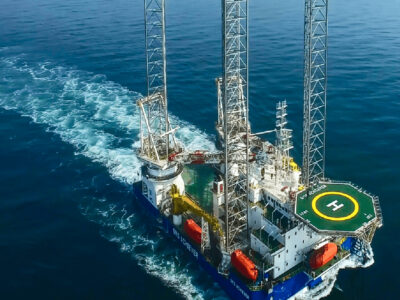DMSat-1, the emirate’s first nanometric environmental satellite, has reached its orbit 550km above Earth following its successful launch from the Baikonur Cosmodrome in Kazakhstan aboard the Soyuz 2.1a space rocket.
The launch was supervised by a team of officials and engineers from Mohammed Bin Rashid Space Centre (MBRSC) and Dubai Municipality.
The first signal from DMSat-1 was received at MBRSC’s mission control centre at 4:42pm local time on Monday, signalling that the satellite had reached its orbit and begun its scientific mission.
Under the supervision of MBRSC, once the testing of onboard subsystems and instruments is completed and verified, the satellite will move into its operational phase, in which it will monitor, collect and analyse environmental data as well as measure air pollutants and greenhouse gases.
The satellite was installed onboard the Soyuz 2.1a rocket earlier this month and completed pre-launch tests on March 12. The rocket carrying the satellite was then transported to the launch site on March 17 in preparation for the launch day.
During the second phase, set to commence in the coming days, the satellite will monitor, collect and analyse environmental data, measure air pollutants and greenhouse gases, develop maps of the concentration and distribution of greenhouse gases as well as study and monitor seasonal changes of these gases.
The data provided by the satellite will be used to find solutions and develop long-term plans to confront the challenges of urban pollution and climate change and explore the future environmental reality in Dubai and the UAE.

According to a statement, DMSat-1 confirms the UAE’s commitment to the terms of the Paris Climate Agreement, which calls for the provision of information and data on greenhouse gas emissions, as well as building national capacities in the field of studying and analysing the phenomenon of global warming.
Dawoud AlHajri, director general, Dubai Municipality, said: “DMSat-1 is an embodiment of the will to excel that characterises the UAE. Guided by the wisdom of our leadership, our national space programme has been able to engage in qualitative areas and enhance its contributions to human civilisation.“The DMSat-1 has the ability to send and receive accurate images to enhance the environmental monitoring system in addition to monitoring the concentrations of suspended particles in dust as well as the concentrations of gases like carbon dioxide, methane and water vapour that cause the phenomenon of climate change,” he added.
Hamad Obaid AlMansoori, chairman, MBRSC, said: “Today we have succeeded in adding a new milestone that reflects the UAE’s determination to be at the forefront of space research, and harnessing science and technology in the service of humanity.
“The DMSat-1 satellite constitutes a new impetus for the UAE to achieve its developmental strategies and make it the leading country in the world capable of using the latest global technologies to build sustainable cities. The satellite will contribute to providing accurate scientific information that helps decision-makers take necessary measures to improve the environment.”
Yousuf Hamad AlShaibani, director general, MBRSC, said: “Our goal is to move confidently towards achieving the UAE’s ambition to establish a strong technology and research base that will contribute to the implementation of the national strategy of building a knowledge-based economy, developing national cadres and strengthening the capabilities of local institutes in order to achieve future goals.”
Weighing 15kg, the DMSat-1 satellite contains state-of-art scientific instruments to monitor air quality and detect greenhouse gases as well as fine particles in the atmosphere. Data will be stored on the onboard storage system and downloaded to MBRSC’s ground station.
Over a period of three to five days, the satellite will monitor a single site more than once from seven different angles. It will orbit the earth 14 times a day and will pass over the MBRSC ground station four to five times a day to receive new imaging orders and enable downloading of data.








